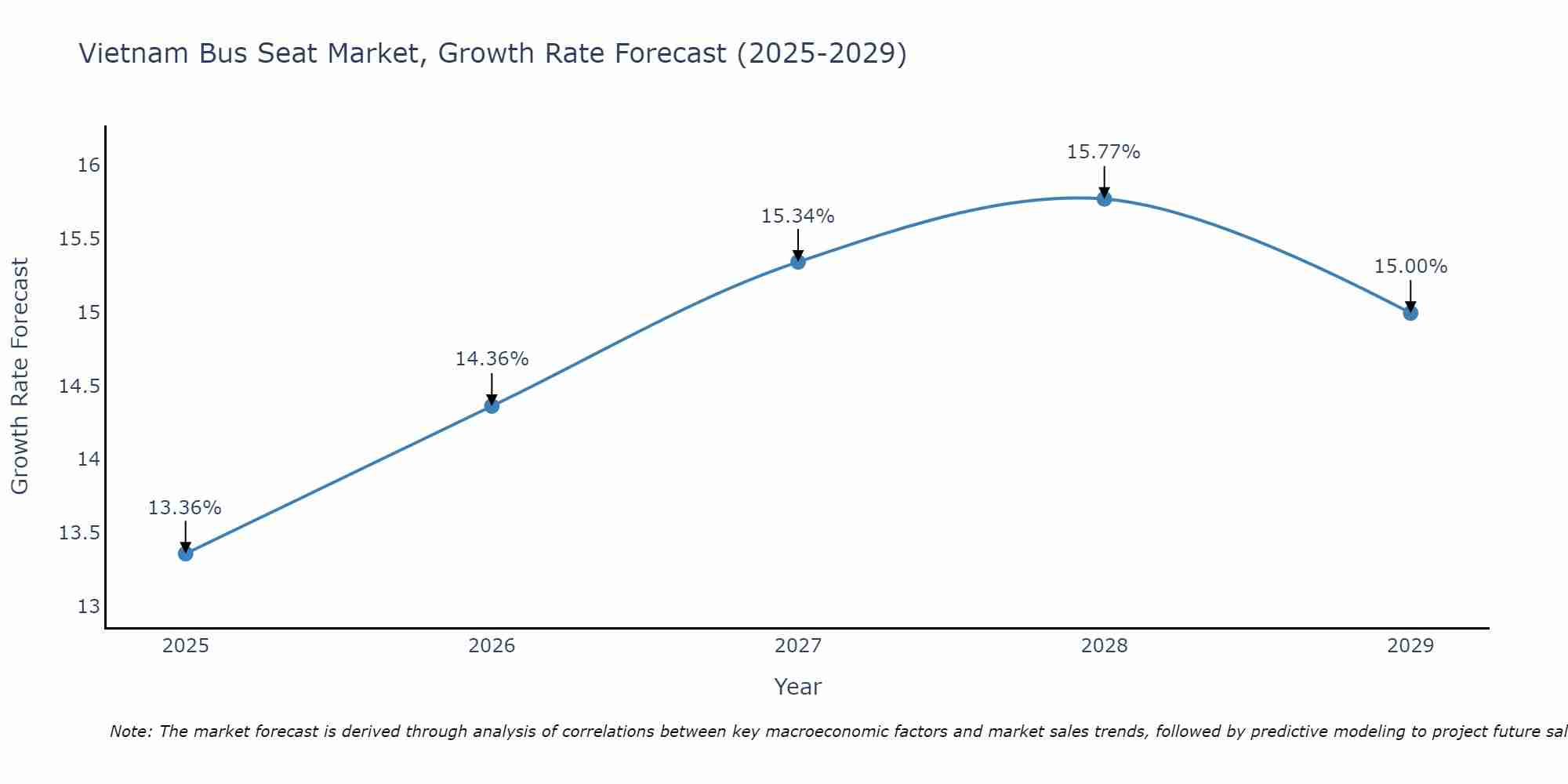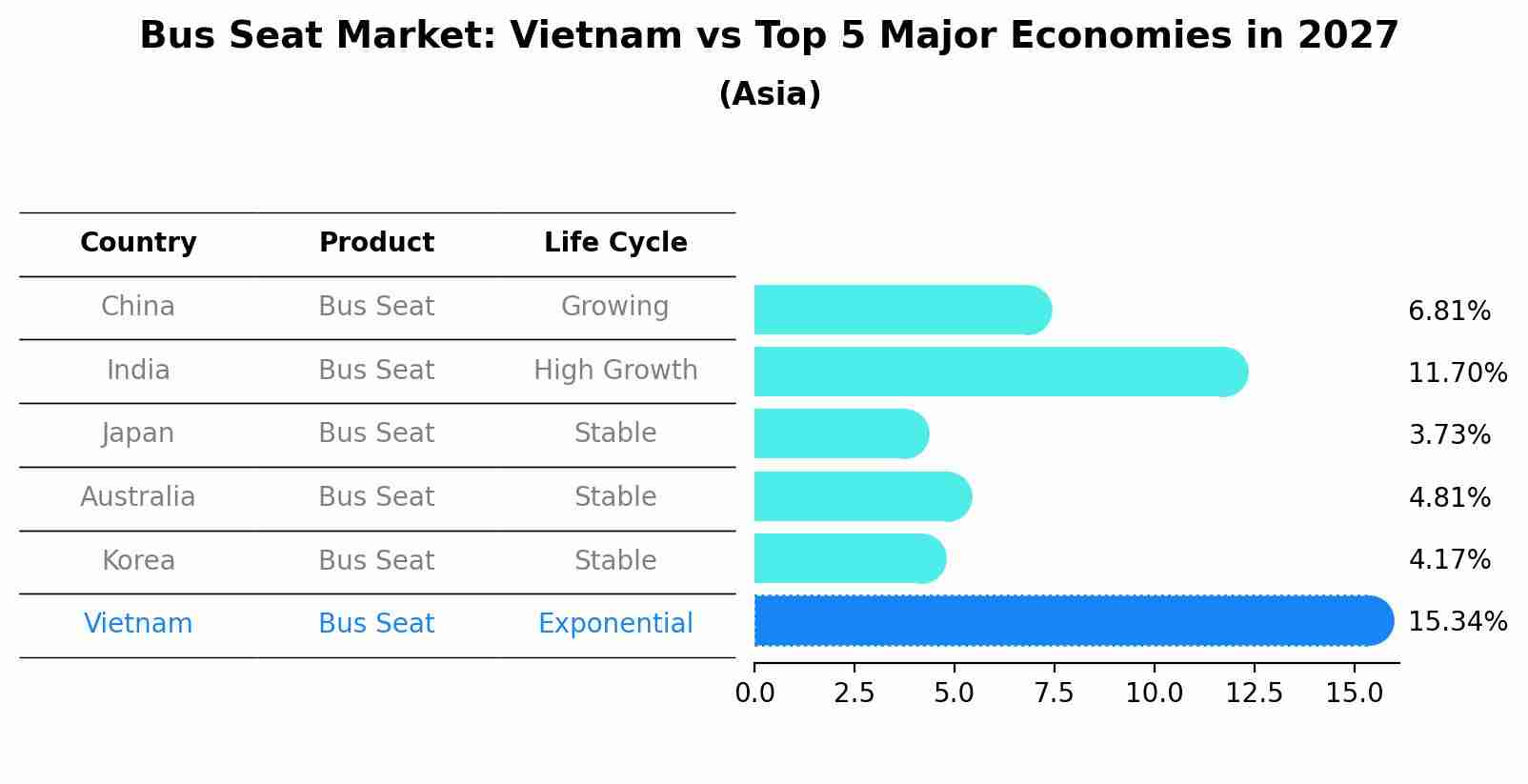Vietnam Bus Seat Market (2025-2031) Outlook | Share, Growth, Revenue, Industry, Trends, Size, Analysis, Companies, Value & Forecast
Market Forecast By Seat Type (Standard, Recliner), By Component Type (Frame, Upholstery) And Competitive Landscape
| Product Code: ETC371070 | Publication Date: Aug 2022 | Updated Date: Apr 2025 | Product Type: Market Research Report | |
| Publisher: 6Wresearch | Author: Ravi Bhandari | No. of Pages: 75 | No. of Figures: 35 | No. of Tables: 20 |
Vietnam Bus Seat Market Size Growth Rate
The Vietnam Bus Seat Market is projected to witness mixed growth rate patterns during 2025 to 2029. Growth accelerates to 15.77% in 2028, following an initial rate of 13.36%, before easing to 15.00% at the end of the period.

Bus Seat Market: Vietnam vs Top 5 Major Economies in 2027 (Asia)
The Bus Seat market in Vietnam is projected to grow at a exponential growth rate of 15.34% by 2027, highlighting the country's increasing focus on advanced technologies within the Asia region, where China holds the dominant position, followed closely by India, Japan, Australia and South Korea, shaping overall regional demand.

Vietnam Bus Seat Market Overiew
The Vietnam Bus Seat market is intricately linked to the country`s transportation infrastructure. As the public and private transport sectors expand, the demand for comfortable and durable bus seats rises. Market players focus on ergonomic designs, safety features, and sustainable materials to meet the evolving expectations of transport operators and passengers. Government regulations and initiatives promoting public transportation impact the market dynamics. Customization options and advancements in seat technologies contribute to the competitiveness of the Vietnam Bus Seat market.
Drivers of the Market
The Vietnam Bus Seat market is witnessing growth due to the increasing focus on public transportation infrastructure. As urbanization progresses, there is a heightened need for comfortable and durable bus seating solutions. Government initiatives to enhance public transportation systems and the rising demand for sustainable mobility are key factors driving the market. Technological advancements in seat design and materials also contribute to the overall appeal of bus seats.
Challenges of the Market
The Vietnam Bus Seat market faces challenges associated with the automotive industry, safety regulations, and design innovations. Fluctuating demand in the automotive sector directly impacts the bus seat market, requiring agile responses to market dynamics. Adhering to stringent safety standards and regulations is crucial, but it also adds complexity to the design and production processes. The demand for innovative and comfortable designs poses a continuous challenge for manufacturers to stay ahead in a competitive market. Successfully addressing these challenges is essential for the sustained growth of the Vietnam Bus Seat market.
COVID 19 Impact on the Market
The COVID-19 pandemic had profound implications for the Vietnam bus seat market. With restrictions on travel and public transportation, the market experienced a sharp decline in demand. Bus operators, facing reduced passenger numbers and financial challenges, delayed or canceled seat replacement and upgrade projects. The market also witnessed shifts in design preferences, with a focus on hygiene and social distancing measures influencing the demand for specific seat configurations. The industry adapted by exploring opportunities in retrofitting existing fleets with enhanced safety features.
Key Players in the Market
In the Vietnam Bus Seat market, major players like KTK Group, SeAH Steel Vina Corporation, and Thaco Group dominate the landscape. These companies specialize in manufacturing durable and comfortable bus seats, contributing significantly to the automotive and transportation sectors in Vietnam.
Key Highlights of the Report:
- Vietnam Bus Seat Market Outlook
- Market Size of Vietnam Bus Seat Market, 2024
- Forecast of Vietnam Bus Seat Market, 2031
- Historical Data and Forecast of Vietnam Bus Seat Revenues & Volume for the Period 2021-2031
- Vietnam Bus Seat Market Trend Evolution
- Vietnam Bus Seat Market Drivers and Challenges
- Vietnam Bus Seat Price Trends
- Vietnam Bus Seat Porter's Five Forces
- Vietnam Bus Seat Industry Life Cycle
- Historical Data and Forecast of Vietnam Bus Seat Market Revenues & Volume By Seat Type for the Period 2021-2031
- Historical Data and Forecast of Vietnam Bus Seat Market Revenues & Volume By Standard for the Period 2021-2031
- Historical Data and Forecast of Vietnam Bus Seat Market Revenues & Volume By Recliner for the Period 2021-2031
- Historical Data and Forecast of Vietnam Bus Seat Market Revenues & Volume By Component Type for the Period 2021-2031
- Historical Data and Forecast of Vietnam Bus Seat Market Revenues & Volume By Frame for the Period 2021-2031
- Historical Data and Forecast of Vietnam Bus Seat Market Revenues & Volume By Upholstery for the Period 2021-2031
- Vietnam Bus Seat Import Export Trade Statistics
- Market Opportunity Assessment By Seat Type
- Market Opportunity Assessment By Component Type
- Vietnam Bus Seat Top Companies Market Share
- Vietnam Bus Seat Competitive Benchmarking By Technical and Operational Parameters
- Vietnam Bus Seat Company Profiles
- Vietnam Bus Seat Key Strategic Recommendations
Frequently Asked Questions About the Market Study (FAQs):
- Single User License$ 1,995
- Department License$ 2,400
- Site License$ 3,120
- Global License$ 3,795
Search
Thought Leadership and Analyst Meet
Our Clients
Related Reports
- Afghanistan Apparel Market (2026-2032) | Growth, Outlook, Industry, Segmentation, Forecast, Size, Companies, Trends, Value, Share, Analysis & Revenue
- Canada Oil and Gas Market (2026-2032) | Share, Segmentation, Value, Industry, Trends, Forecast, Analysis, Size & Revenue, Growth, Competitive Landscape, Outlook, Companies
- Germany Breakfast Food Market (2026-2032) | Industry, Share, Growth, Size, Companies, Value, Analysis, Revenue, Trends, Forecast & Outlook
- Australia Briquette Market (2025-2031) | Growth, Size, Revenue, Forecast, Analysis, Trends, Value, Share, Industry & Companies
- Vietnam System Integrator Market (2025-2031) | Size, Companies, Analysis, Industry, Value, Forecast, Growth, Trends, Revenue & Share
- ASEAN and Thailand Brain Health Supplements Market (2025-2031) | Strategy, Consumer Insights, Analysis, Investment Trends, Opportunities, Growth, Size, Share, Industry, Revenue, Segments, Value, Segmentation, Supply, Forecast, Restraints, Outlook, Competition, Drivers, Trends, Demand, Pricing Analysis, Competitive, Strategic Insights, Companies, Challenges
- ASEAN Bearings Market (2025-2031) | Strategy, Consumer Insights, Analysis, Investment Trends, Opportunities, Growth, Size, Share, Industry, Revenue, Segments, Value, Segmentation, Supply, Forecast, Restraints, Outlook, Competition, Drivers, Trends, Demand, Pricing Analysis, Competitive, Strategic Insights, Companies, Challenges
- Europe Flooring Market (2025-2031) | Outlook, Share, Industry, Trends, Forecast, Companies, Revenue, Size, Analysis, Growth & Value
- Saudi Arabia Manlift Market (2025-2031) | Outlook, Size, Growth, Trends, Companies, Industry, Revenue, Value, Share, Forecast & Analysis
- Uganda Excavator, Crane, and Wheel Loaders Market (2025-2031) | Strategy, Consumer Insights, Analysis, Investment Trends, Opportunities, Growth, Size, Share, Industry, Revenue, Segments, Value, Segmentation, Supply, Forecast, Restraints, Outlook, Competition, Drivers, Trends, Demand, Pricing Analysis, Competitive, Strategic Insights, Companies, Challenges
Industry Events and Analyst Meet
Whitepaper
- Middle East & Africa Commercial Security Market Click here to view more.
- Middle East & Africa Fire Safety Systems & Equipment Market Click here to view more.
- GCC Drone Market Click here to view more.
- Middle East Lighting Fixture Market Click here to view more.
- GCC Physical & Perimeter Security Market Click here to view more.
6WResearch In News
- Doha a strategic location for EV manufacturing hub: IPA Qatar
- Demand for luxury TVs surging in the GCC, says Samsung
- Empowering Growth: The Thriving Journey of Bangladesh’s Cable Industry
- Demand for luxury TVs surging in the GCC, says Samsung
- Video call with a traditional healer? Once unthinkable, it’s now common in South Africa
- Intelligent Buildings To Smooth GCC’s Path To Net Zero


















